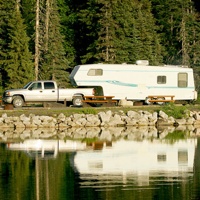Learn more about deep cycle RV batteries
RV tech, Reg DeYoung, shares his in-depth knowledge of RV batteries
At our shop we are often asked, “Which batteries are best, 12-volt or 6-volt?” or, “Why are the 6-volts so expensive compared to the 12-volts.” There are many answers to these questions, and an understanding of the differences between each type of RV battery would be a good place to start.
Firstly, we will be focusing primarily on the wet cell or flooded RV deep cycle batteries commonly found on most RVs today. The starting or chassis battery used by a motorhome is totally different in construction, in that it is designed to deliver quick bursts of power or current thousands of times to the starter motor and then recharge via the alternator as soon as the engine is running on its own. They are rated in (CCA) cold cranking amps, and if these batteries are heavily discharged and recharged too often their life cycle will be significantly shortened.
The RV deep cycle battery is designed for delivering small amounts of current over extended periods of time to operate the lights, water pump, furnace, etc. The electrolyte mixture of 36 per cent sulphuric acid and 64 per cent water may be the same as a starting battery, but the flooded wet cell deep cycle battery will contain much thicker lead plates which will allow frequent discharges and recharges without damaging the surface of the plates.
Inside the battery one plate is positive and the other is negative. As the battery delivers power or discharges, the acid in the electrolyte enters the positive and negative lead plates. The electrolyte becomes weaker and the specific gravity or weight of the electrolyte compared to the weight of water starts to change until the solution can no longer provide a sufficient amount of voltage.
Important differences
RV deep cycle batteries are rated much differently than the starter battery using cold cranking amps, which is the maximum load a fully charged starting battery can deliver for 30 seconds at 0°F (-18°C) while maintaining at least 7.2 volts. The deep cycle RV battery is rated by reserve capacity, with the addition of amp hours listed. Reserve capacity is the number of minutes at 80°F (26°C) the battery can deliver 25 amps until it drops 10.5 volts. Usually the loads required during the summer camping season are much lower and the reserve capacity will last much longer at these lower discharge rates.
The amp/hour (amp/hr) rating is the amount of current that can be drawn from a battery for 20 hours before the voltage drops to 10.5 volts.
These batteries are usually known as group 24 or group 27, and you should always check to see if a group 27 fits your battery tray or compartment before you make a purchase, as they are slightly longer than a group 24 battery.
As preventative maintenance, checking the battery frequently will increase the longevity or life cycle of the battery. There are three methods for testing the battery and the first procedure involves safety. Anytime you are handling or working around batteries you must be cautious, as sulphuric acid can cause severe chemical burns. In the unfortunate event that you are exposed to acid, flush the area immediately with water and seek medical attention. Avoid contact to the skin and eyes by wearing safety goggles and leather gloves.
The first test would involve the use of a specific gravity tester or hydrometer. This tool measures the weight of electrolyte compared to the weight of the water. A reading of 1.265 would be a 100 per cent charge level and 1.120 is a completely discharged battery. If one cell is reading significantly different, this would be considered a bad cell and the battery would need to be replaced.
The next test would be a voltage measurement to determine the state of charge of the battery, although this test does not check the performance of the battery. If the voltage is 12.6 or slightly higher it would be at 100 per cent state of charge with 11.7 volts being fully discharged.
The final test can be done with an adjustable load tester, usually found at your local auto or RV service centre. This tool will apply a specific load for a predetermined amount of time to remove the surface charge and simulate a heavy load. This test is best done by a technician with knowledge of the procedures required to properly perform the test.
Other points to consider
The deep cycle RV batteries are usually charged by the alternator while travelling, the power convertor when plugged into shore power or by the addition of solar panels. It must be first noted that deep cycle batteries will last longer if charged at minimum amps over longer periods of time. If you are using a compact battery charger from a parts store make sure you charge the battery in a well ventilated area and if the battery becomes hot or is gassing you should take it off charge by first turning the machine off and then remove the charge cables to avoid sparking.
Never try to charge a frozen battery—either a RV deep cycle or starting battery—as an explosion may result with serious injuries to the bystanders.
You should check the water levels at least once a month and try not to overfill the cells, especially before a charging cycle, as the electrolyte may overflow out the top of the battery. Use distilled water for improved battery performance. It has been stated that 85 per cent of 12-volt batteries fail before they should.
When hooking up deep cycle RV batteries there are two different wiring types. A parallel hook-up is used when there is more than one 12-volt battery. The positive posts are connected together, as are the negative posts.
For improved performance try and hook the positive from the coach to one battery and the negative from the coach to the other battery.
A series connection is used for six-volt batteries to produce the 12 volts required by the RV. In series, the negative from one battery post is hooked to the positive post of the other battery with the remaining posts hooked to the negative and positive leads from the RV. By using golf cart or EV (electric vehicle) batteries you will be provided with a higher reserve capacity rating and improved discharge cycle times over the average RV deep cycle battery.
Try and keep the batteries compatible in brand, type and age to minimize any interactions that may reduce their longevity or performance.
Since most of us have stored our RVs, it is advisable to remove the batteries and place them in a cool, dry area. Clean the top of each battery with a mixture of baking soda and water, usually a pound of baking soda per gallon of water is best. You can also purchase special products for cleaning and protecting the surface and posts. Check the battery with a hydrometer once a month and recharge the battery at low amperage when required.
If the electrolyte levels are checked and proper charging procedures are followed, your battery will perform better and have an improved life cycle when reinstalled in the spring.



